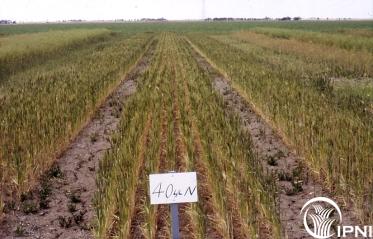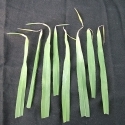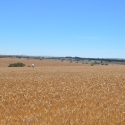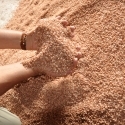Nitrogen - how much is enough?
 Wheat 40 kg N/ha
Wheat 40 kg N/ha
Introduction
Because nitrogen use on grain crops has now become a tactical issue in response to seasonal conditions, is always a topic of conversation. Some worry that they skimped and missed yield while others may think that what they applied either did not work or gave only a small response. Others worry that there were big losses in what they applied so wasted a lot of the N applied.
To answer the question how much is enough, draws another question – how much do you want to spend and how much yield are you willing to miss out on. In most cases, the amount of N is budgeted for and so chasing yield is can be limited by the amount to be spent. Risk is also a big part of the question – around the probability of getting a profitable return.
Figure 1 Grain yield (t/ha) and protein concentration (%) from 10 wheat varieties with 0, 30, 60, 90 and 120 kg/ha applied nitrogen in a trial at Parkes in 2011.(Brill et al, 2012, http://www.grdc.com.au/Research-and-Development/GRDC-Update-Papers/2012/04/Comparison-of-grain-yield-and-grain-protein-concentration-of-commercial-wheat-varieties)
At a crop level, grain protein can be an estimate of the degree of N limitation a crop has undergone. Proving grain size is good, wheat grain protein concentration generally has a strong inverse relationship with grain yield but with increasing N supply yield and protein converge (Figure 1). This relationship has a large genetic component so some varieties express higher levels than others, and the response is also affected by rainfall/water supply particularly after anthesis.
If the upper limit to grain protein for a variety is known, then grain protein can help us understand the degree of N limitation during the season. Figure 1 shows the yield and protein relationship that is generally held, and as N supply increases, yield initially increases to a maximum, but protein is slower to resolve so and so if grain protein is low with a higher yield, it suggests that N was limited.
Even so, a series of 8 experiments undertaken across the high rainfall zone showed that even in seasons where the finish is good, there is no single strategy to achieve grain protein above 10.5% with a high yield. While early N can establish a platform for high yields, the right combination of source, rate and timing to take advantage of any premiums still relies on a little luck with the conditions that follow application (see http://anz.ipni.net/article/ANZ-3207).
Agronomic manipulation using 4R nutrient stewardship.
The first aspect of ensuring N is used efficiently and effectively is to ensure that other issues such as sodicity, salinity, acidity, other nutrients, pests, weeds or diseases are not the limitation. A simple way to do this is to use a N-rich strip in a paddock. This will serve as a reference for later in the season as well as give some early indications if additional N is giving a response, and even if further N could provide extra benefit.
Given that, there are some indicators that can be considered around effective and efficient N use:
Right Time
The earlier N is applied, the larger the yield increase, while the later the N is supplied, the larger the protein increase. Basically, the N supplied will most affect the tissue that is actively growing at that time. Early N N stimulates shoots or tillers, while later N can increase stem growth. Once active stem growth slows, later N can be used in grain filling.
Table 1 shows the results of a small experiment where 20 kg N/ha was applied as urea at different times to a wheat crop at Horsham. The later applications gave progressively smaller yield responses, while the protein response increased except when applied during early dough. This also shows that the 20 kg N applied showed lower recovery as application delayed.
Table 1. Responses of wheat (cv Yitpi. 2001, Longerenong) to 20 kg N/ha applied at different crop stages, relative to nil added N.
N applied at: | ||||||
| Responses | Nil N | DC31 | DC42 | DC65 | DC72 | LSD p>0.05 |
| Yield (t/ha) | 3.31 | 3.94 | 3.23 | 3.29 | 3.14 | 0.31 |
| Protein (%) | 8.6 | 9.4 | 10.4 | 9.8 | 8.9 | 0.4 |
| N recovered (kg N/ha) | 50 | 65 | 59 | 57 | 49 | |
| % Recovery | 75% | 44% | 33% | -4% | ||
Right rate
While timing and form often get the main interest, getting rate right is as important. The key question here is if the crop is actually N limited, and unless this is the case there will be no response and so a low efficiency. Nitrogen budgets reviewed with yield estimates such as from Yield Prophet® are vital to estimate demand, while supply from deeper in the soil or mineralised N will also be important (but often estimated). The rate can be determined based on having adequate N in the crop by anthesis to match the yield and protein target. A 3.5 t/ha grain yield will probably come from a biomass at anthesis of 7 t/ha and to meet a 11% protein target should have around 120 kg N (do the maths up or down). If the post-anthesis conditions are better than the target, then N will be diluted by the extra growth and grain protein decline. If conditions are worse, then grain protein increases. So, the actual yield response will depend on the N rate meeting the gap between the target demand and expected supply (neither of which we know in advance). So there is some luck here in what outcome occurs.
Right place
Having the N isolated from losses due to ammonification, denitrification and leaching mean that – if the crop really needs the N – it can access it with minimal loss. Putting all the N up-front would suggest a good efficiency, but this is when seasonal conditions are least known and so demand is still being formed, and the decision on rate can only be adjust up – not down. It is also important to caution about fertilizer – especially urea – placed in a seed-row. Poor establishment due to damage to germinating seeds can be significant with wide rows, narrow points, light soils and dry conditions (see http://anz.ipni.net/article/ANZ-3076). A 3-5 cm separation between fertilizer and seed is adequate to minimize damage.
Inter-row banding pre-crop or even in-crop (side-banding) is an attractive option as it buries the N but the technologies around this require more refinement.
However, in most situations, the placement for in-crop application will be over the top of the crop. For dry fertilizers, most will end up on the soil and the fate for urea is to become either ammonia which can be lost, or as plant available ammonium or nitrate. Leaves can absorb inorganic and organic nitrogen sources. Small pores within leaf cuticles can take up urea, ammonium and nitrate. These pores are lined with negatively charged molecules. Therefore, uptake of cations (such as ammonium) is faster than anions (such as nitrate). Uptake of small, uncharged molecules, like urea, is fast. Urea is commonly used for foliar fertilization because of its uncharged, has high solubility and can be rapidly and efficiently absorbed by leaves (Fernandez et al. 2013).
For fluid fertilizers, such as urea or urea/ammonium nitrate solutions, depending on the application equipment used, some proportion of the material will intercept the crop canopy and some will hit the soil. Once on the soil, the loss processes are the same for dry fertilizers, but the N on the canopy can be taken up through the leaves.
Foliar applied N has been proposed as the most efficient method to present N, and urea is rapidly and effectively taken directly through the leaf surfaces. For highest efficiency, coverage should be good, but crops are susceptible to damage both from urea itself as well as the salt effect of the solution. This urea toxicity will dictate the upper level for effective N uptake, and it is probably around 10-15 kg N/ha depending on crop cover, ambient conditions, and application technology. Streaming nozzles really place fluids on the inter-row rather the canopy, and while reducing canopy damage, they do expose the material to soil surface losses under the canopy.
Right source
Many of the comparisons of N sources (products) confound the source with both the placement and timing effects, but where N for N comparisons at similar timings are made, differences in recovery of applied N and yield responses are small (Gooding et al. 2007). However, there are quite large differences in cost (Doyle 2013) that need to be balanced against benefits gained.
For surface applied N, two experiments showed losses to ammonification as urea (23%), urea/ammonium nitrate (12% and sulfate of ammonia (12%) for 9 days between application and light rainfall on an alkaline vertosol (Turner et al. 2012). In a similar earlier experiment, the loss of N from urea can be reduced from 10% to 1% of applied N through the use of an urease inhibitor (Turner et al. 2010), although the efficiency of this reduction was reduced at higher temperature and higher soil organic C content (Suter et al. 2011).
At Birchip in 2013 (McClelland, pers. comm.) showed that N uptake from both UAN (streaming nozzles), urea solution (flat fan nozzles) and dry urea (top-dressed) was similar 10 days after application (DC31). However, by anthesis the UAN (streaming nozzles) and dry urea had more N in the crop than the urea solution. By maturity there were no yield differences, although the UAN and dry urea had higher grain protein contents than the urea solution.
Fluid fertilizers offer the opportunity to combine two operations so reducing paddock traffic, as well as giving options for additional nutrients such as S or micronutrients. There are also many other factors at play rather than just selecting an N source to get more N Into the crop, and then achieving a profitable yield response. However, in my opinion there would need to be compelling circumstances where expected losses are high to justify moving away from top-dressed urea, provided as the season unfolds.
Way Forward:
1. Try N-rich strips in fields to see where the response could be sitting.
2. Unless springs are good to very good, there will be little benefit from N applied later than booting, and much of this may be as a protein response.
References
Fernandez et al. 2013. Foliar Fertilization, Scientific Principle and Field Practices. International Fertilizer Industry Association. (http://www.fertilizer.org/HomePage/LIBRARY/Our-selection2/Fertilizer-use.html/Foliar-Fertilization-Scientific-Principles-and-Field-Practices.html)
Gooding and Davies. 1992. Fertilizer Research, 32, 209-222.
Gooding et al. 2007. Field Crops Research, 100, 143-154.
Suter et al. 2011. Soil Research, 49, 315-319.
Turner et al. 2010. Agriculture, Ecosystems and Environment, 137, 261-266.
Turner et al. 2012. Nutrient Cycling in Agroecosystems,93, 113-126.




